Choosing the right pliers for your rings and your hands will make all the difference.
#1 – Look for pliers with springs.
Without springs, you’d need to “use up” fingers for opening the jaws – much better to save as many fingers as you can for manipulating your chain and your rings.
harder to use.
easier to use.
It’s also important to look for soft springs. If the springs are too stiff, you’ll need to fight past them each time you grip a ring. That will not only make your hands tire more quickly, it will also make it more likely that you’ll develop the Death Grip and dent your rings by over-squeezing. More on the Death Grip in the section on Perfect Closures.
#2 – Look for the right jaws.
Different pliers have different jaw shapes and sizes. Generally speaking, jaw size should match ring size. You’ll want to experiment a bit to find what feels right to you, but here are my opinions as a starting point:
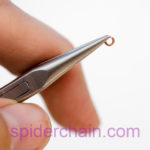
I use these micromail pliers for truly tiny rings in tight weaves – 22ga and 21ga only. Shown with size 4:22cu.
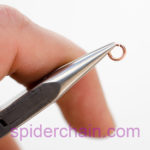
Chain-nose pliers are useful for a range of sizes. I use them for 22ga up through 17ga. Chain-nose pliers grip best when they come in at a steep angle so they have a nice broad grip. Shown with size 8:19cu.
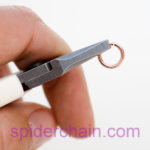
Flat-nose pliers are the workhorse of chain mail. They’re a good choice for a wide range of sizes. I use them for 19ga up through 14ga. Flat-nose pliers will have a good, broad grip even if they approach the ring at a shallower angle. However, they are bulkier than chain-nose, which can be a problem with small diameter rings. Shown with size 16:16cu.
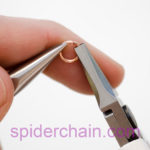
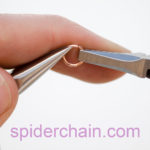
Most of the time I’m working in the “overlap” gauge range of chain-nose and flat-nose, so most of the time I use one of each. I like to have chain-nose in my off hand (left), where it will hold at a steady angle and take up very little room gripping the ring. I like to have flat-nose in my dominant hand (right), where it can be nimble and come in at a variety of angles. Is this the one true way to use your pliers? Absolutely not! For the first many years of my chainmailling life I only used chain-nose, even for 14ga. I did just fine. I know plenty of chainmaillers who use only flat-nose, even for 22ga. They do just fine. Find out what works for you.
And now… some unusual pliers jaws:
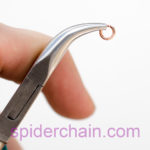
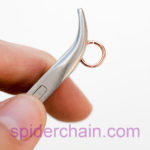
These are bent-nose pliers, though I like to call them Gonzo-nose (remember Gonzo? from The Muppet Show?) These pliers try to be the best of both worlds: hold them one way and they have the dainty grip of chain-nose, flip them over and they have the broad grip of flat-nose. Personally, I find that they do neither job as well as single-purpose pliers, but I know that some people adore them.
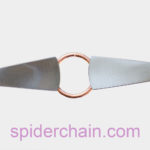
If you’re working with big rings (15ga and up), duckbills are great. The thing to remember is that you come at the ring straight from the sides. I usually scold my students if they get “chicken wings” while they’re working, but these pliers are the exception. Stick those elbows out! Come in straight from the sides to give those super-wide jaws an even grip across the ring.
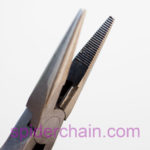
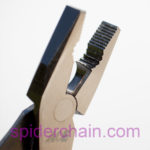
If you plan to work with stainless steel or titanium, you’re going to want pliers with teeth. Do not use toothed pliers on any of the rings that I sell! The teeth make it easier to keep a grip on stubborn metals, but they’ll chew up the precious metals that I specialize in. I don’t sell these toothed pliers, but you can find something similar at your local hardware store. As with jeweler’s pliers, look for return springs and use smaller tips for smaller rings, larger tips for larger rings.
#3 – Look for the right handles.
The final piece to consider when choosing pliers is your hand size. I have medium-ish hands, so most pliers are comfy for me, but not everyone is so lucky. Let’s look at a few handles:
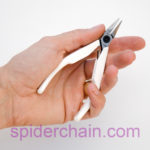 Lindstrom White Handles:
Lindstrom White Handles:
These are the pliers that I started out using, and I still love them. The handle shape is good, and the hard plastic surface gives a nice feel – easy to grip without feeling sticky. Some of my students say that the ends of the handles dig into their palms. I don’t find that to be an issue because I scoot forward on my pliers (read more about my pliers grip in Perfect Closures), but if your hands are especially large these might not fit well. I carry Lindstrom pliers in chain-nose, flat-nose, and bent-nose.
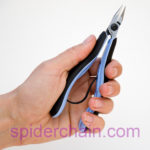 Lindstrom Ergo:
Lindstrom Ergo:
These are also made by Lindstrom, but I don’t personally use them. The shape of the handles is absolutely glorious – if you keep your hands where they’re “supposed to be.” I always scoot my hands way up on my pliers, which doesn’t work well here. That said, these are incredibly comfortable pliers when used as intended, and the spring is adjustable too. Any time a student comes to me with hand issues (arthritis, surgery, nerve damage, etc.) I steer them toward the Lindstrom Ergo pliers. I carry Lindstrom Ergo pliers in chain-nose, flat-nose, and bent-nose.
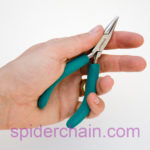 Baby Wubbers:
Baby Wubbers:
A relative new-comer (I started carrying them in 2011), Baby Wubbers are a wonderful addition to the chainmailler’s toolbox. The curve of the handles doesn’t fit my own hand shape as well as my Lindstroms, but they’re easier to grip and the handle ends don’t poke as much. I carry two pairs of pliers with me (almost) all the time. I like to mix it up a bit, swapping handles and jaws around, but one pair is always Baby Wubbers. I carry Baby Wubbers in chain-nose, flat-nose, bent-nose, and round-nose (that last is for wire loops, not for jump rings).
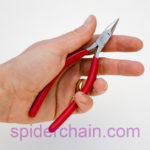
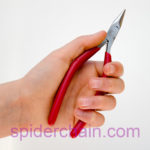
Economy Ergo:
If you have especially small hands, these are the pliers for you. The handles are quite long, but with a narrow profile when they’re closed, making it easier for shorter fingers to wrap around them. You can see my daughter’s ten-year-old hand in that second picture – she’s perfectly comfortable with these pliers. And they’re not just for chainmaillers with small hands – these are great pliers for anyone who wants low-profile handles. The only thing I don’t like about them are the slightly gummy rubber-dipped handles. If your skin is dry, the slight stickiness might be an advantage, but I’m not crazy about how it feels. I carry Economy Ergo pliers in chain-nose and flat-nose.
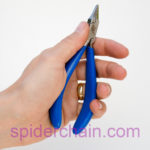 Ultra Ergo:
Ultra Ergo:
If you have especially large hands, these are the pliers for you. They weigh more than the other handle options, but that’s because the Ultra Ergo handles are broader and contoured to fit comfortably without digging in. I find that I can’t scoot super-close to the jaws (similar to my problem with the Lindstrom Ergos, but not as extreme), so I don’t use them in my off hand (left). However, I don’t need to scoot as close with my dominant hand (right), so these work fine there. When I sit down for a mailling marathon, these are what I want for my right hand. The handle shape is comfy enough that I forgive them their slightly sticky dipped-rubber feel. I sell Ultra Ergo pliers in chain-nose and flat-nose.
Happy chainmailling!
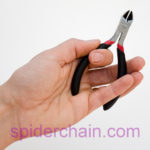
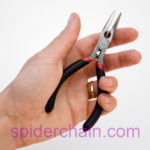
Spider do you recommend a certain type of tool to work with niobium rings, do they scratch easily?
Any jump ring will scratch if your pliers slip off the ring while you’re squeezing. Those scratches are more noticeable on niobium because the color layer is only on the surface. I control slip-off by connecting my hands when I work. You can see a picture of my connected hand position in the “Mangled” section of the Perfect Closures blog post. I do still scratch the niobium, but it’s much, much less frequent.
If you want a more reliable solution, get some Tool Magic. It’s a rubbery coating for your pliers tips. Dip them, let it dry, and then work with zero scratches. Rebeca of Blue Buddha Boutique first introduced me to Tool Magic. She recommends a couple thin layers instead of one thick layer to make it last longer. And yes, you do have to re-coat periodically. I’ve seen Tool Magic in the Firemountain Gems catalog, and I’m sure you can find it plenty of other places. (If you have a local craft store, check there. Shop local! *grin*)
That said, I don’t personally use Tool Magic. I scratch rings infrequently enough that it’s not worth the fuss. But there’s another reason to chainmail with “naked” pliers. If you are scratching up your rings, it usually means that you’re gripping hard, trying to keep the ring in your pliers. Gripping hard is bad for jump rings, and also bad for your body. I use the feedback from my rings to keep me honest about maintaining a light grip, keeping my motions small, leaving my larger arm/shoulder muscles out of the picture. It’s so easy to get caught up in the pattern, trying to force the ring into place, hunched over and tense – and then my neck/shoulders feel awful. Far better to stay relaxed with a light touch – and the feedback of scratched rings helps me do that.
I know I digressed a bit, but I hope that answered your question. I suppose I should explicitly say that you need to use good quality pliers. Some toothless pliers have a little burr at the edges which is doom for jump rings. Check for that and sand them down with emery paper if needed.
Happy chainmailling!
I have 10 g chain with a matte blk coating on a spool. I also have Swanstrom Delrin chain nose pliers with non marring coating. These pliers keep slipping. Please!! Any advise on what to use would be greatly appreciated!
It sounds like you need pliers with more grip. Try flat nose pliers instead.
And… if the material you’re working with is tough (the chain might be made of steel) you may need to resort to pliers with teeth.
Tell me a bit more about the chain you’re working with. What metal is it made of? And when you say 10 gauge, do you mean that the wire of the chain is 10 gauge, or that the overall chain size is 10 gauge?